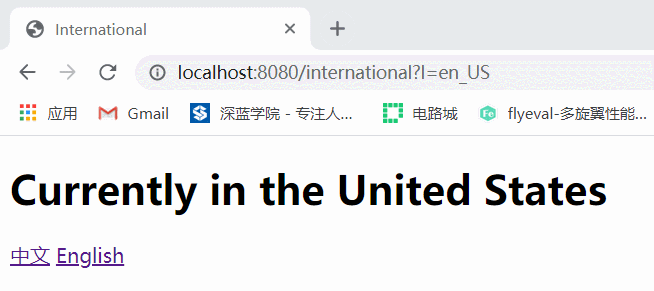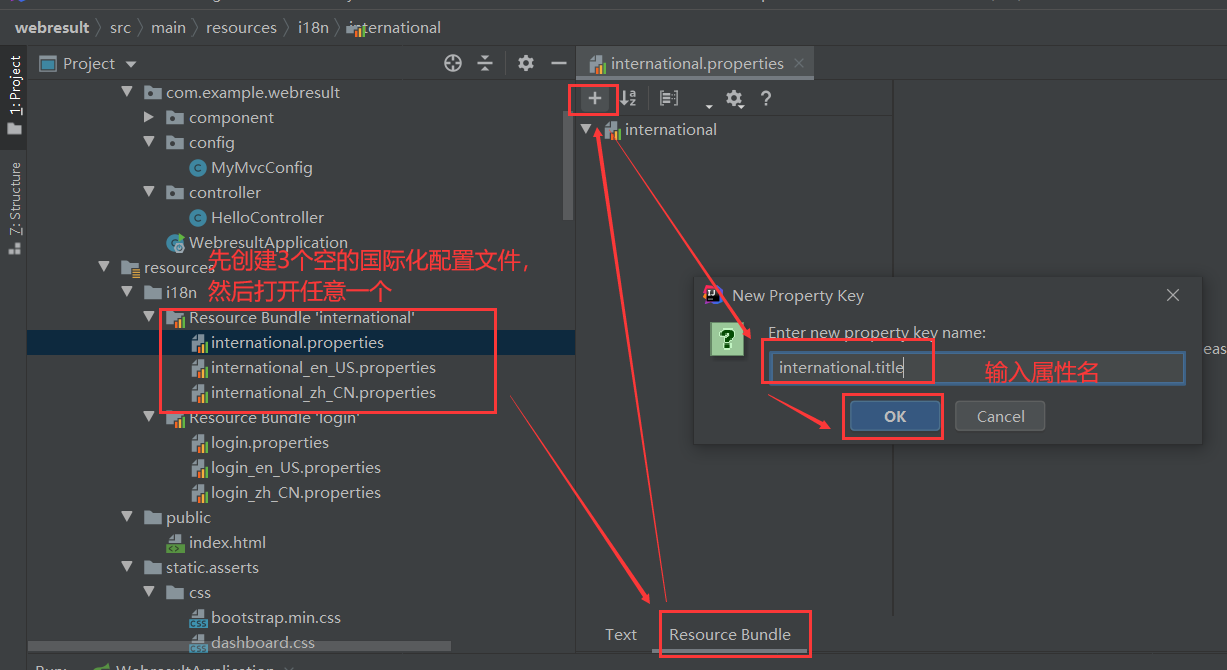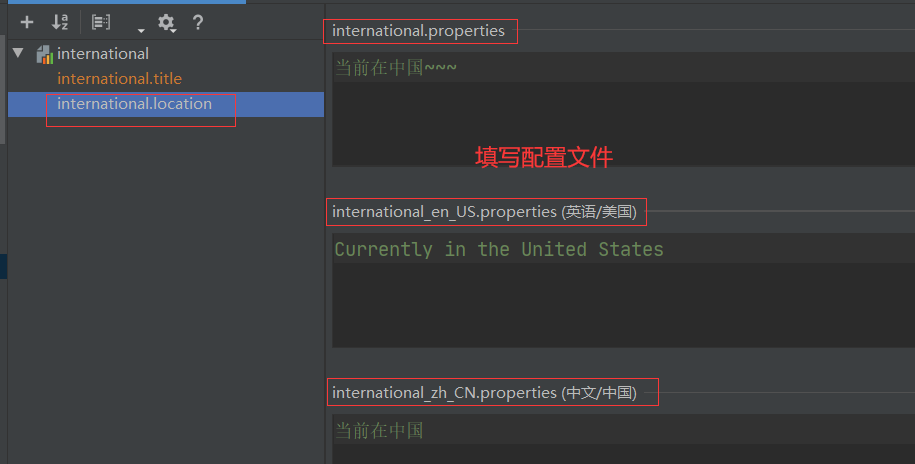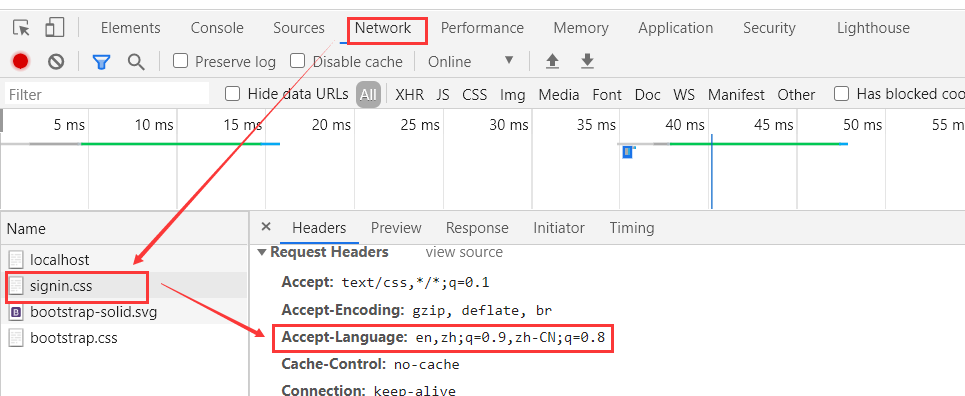國際化就是根據需要能夠將網站的語言切換為當地語言信息,如可以將網站在中英文之間進行切換。

我們可以實現根據瀏覽器使用的默認語言來實現網站語言的切換,或定制我們的區域信息解析器來實現點擊鏈接切換語言。
<br/>
步驟如下:
**1. 明確需要國際化的地方**
假如我需要將`templates/international.html`頁面進行國際化。
```html
<!DOCTYPE html>
<html xmlns:th="http://www.thymeleaf.org">
<head>
<meta charset="UTF-8">
<!-- international.title 是下面國際化配置文件的屬性名 -->
<title th:text="#{international.title}">國際化</title>
</head>
<body>
<h1 th:text="#{international.location}">當前在中國</h1>
<!-- 需要傳遞一個l的參數讓后臺知道要使用的是哪種語言 -->
<a th:href="@{/international(l=zh_CN)}">中文</a>
<a th:href="@{/international(l=en_US)}">English</a>
</body>
</html>
```
**2. 編寫國際化配置文件**
國際化配置文件統一使用`.properties`來編寫,命令規則為:`頁面名_語言_國家編碼`,如中文配置文件:`international_zh_CN.properties`、英文(美國)`international_en_US.properties`。
先創建三個空的國際化配置文件,如下圖:

`international.properties`的作用是當沒有提供對應的國際化配置文件時,默認采用該配置文件。

最終填寫如下:
**`resources/i18n/international.properties`**
```xml
international.location=當前在中國~~~
international.title=國際化~~~~
```
**`resources/i18n/international_zh_CN.properties`**
```xml
international.location=當前在中國
international.title=國際化
```
**`resources/i18n/international_en_US.properties`**
```xml
international.location=Currently in the United States
international.title=International
```
**3. 指定國際化配置文件的位置**
國際化配置文件默認在`resources`目錄,但是我們更改為`resources/i18n/`目錄,所以需要指定。
**`resources/application.properties`**
```xml
# 當你有多個國際化配置文件時用 , 隔開
spring.messages.basename=i18n.login, i18n.international
```
**4. 啟動項目訪問`international.html`頁面**
當你訪問到該頁面,由瀏覽器的默認語言來決定使用哪個配置文件。下圖為我的谷歌瀏覽器默認的語言為簡體中文,所以采用是`international_zh_CN.properties`的配置信息。

上面網站的語言由瀏覽器當前的默認語言決定,但是我們可以在頁面放置鏈接任意在中英文之間切換。
其原理是:可以使用區域信息解析器LocaleResolver來獲取國際化Locale,它的部分源碼如下:
```java
-----WebMvcAutoConfiguration-----
public LocaleResolver localeResolver() {
// 如果沒有指定區域信息,則使用默認的FIXED
if (this.mvcProperties.getLocaleResolver() ==
org.springframework.boot.autoconfigure.web.servlet.WebMvcProperties.LocaleResolver.FIXED) {
return new FixedLocaleResolver(this.mvcProperties.getLocale());
} else {
// 如果沒有指定,則從AcceptHeaderLocaleResolver獲取區域信息
AcceptHeaderLocaleResolver localeResolver = ▲▲▲▲new AcceptHeaderLocaleResolver();▲▲▲▲
localeResolver.setDefaultLocale(this.mvcProperties.getLocale());
return localeResolver;
}
}
-----AcceptHeaderLocaleResolver-----
public Locale resolveLocale(HttpServletRequest request) {
Locale defaultLocale = this.getDefaultLocale();
if (defaultLocale != null && request.getHeader("Accept-Language") == null) {
return defaultLocale;
} else {
// 從請求頭中獲取區域信息
▲▲▲▲Locale requestLocale = request.getLocale();▲▲▲▲
List<Locale> supportedLocales = this.getSupportedLocales();
if (!supportedLocales.isEmpty() && !supportedLocales.contains(requestLocale)) {
Locale supportedLocale = this.findSupportedLocale(request, supportedLocales);
if (supportedLocale != null) {
return supportedLocale;
} else {
return defaultLocale != null ? defaultLocale : requestLocale;
}
} else {
return requestLocale;
}
}
}
```
在瀏覽器中按F12,找到任意一個請求,可以看到請求頭部的語言信息,我們需要定制自己的信息解析器來解析的請求頭部信息。

**5. 實現我們自己的區域信息解析器**
*`com.example.webresult.component.MyLocaleResolver`*
```java
package com.example.webresult.component;
import org.apache.tomcat.jni.Local;
import org.springframework.web.servlet.LocaleResolver;
import org.thymeleaf.util.StringUtils;
import javax.servlet.http.HttpServletRequest;
import javax.servlet.http.HttpServletResponse;
import java.util.Locale;
public class MyLocaleResolver implements LocaleResolver {
@Override
public Locale resolveLocale(HttpServletRequest request) {
// 獲取從前端請求的參數l
String l = request.getParameter("l");
// 如果沒有請求參數l,則使用默認區域
Locale local = Locale.getDefault();
if (!StringUtils.isEmpty(l)) {
String[] split = l.split("_");
// 創建我們自己的區域,(國家語言, 國家編碼)
local = new Locale(split[0], split[1]);
}
return local;
}
@Override
public void setLocale(HttpServletRequest httpServletRequest, HttpServletResponse httpServletResponse, Locale locale) {
}
}
```
**6. 將定制的區域信息解析器注冊到IoC容器中**
需要將上面定制的區域信息解析器注冊到IoC容器中,讓我們的區域信息解析器起效,覆蓋SpringMVC默認的解析器。
*`com.example.webresult.config.MyMvcConfig`*
```java
package com.example.webresult.config;
import com.example.webresult.component.MyLocaleResolver;
import org.springframework.context.annotation.Configuration;
import org.springframework.web.servlet.LocaleResolver;
import org.springframework.web.servlet.config.annotation.WebMvcConfigurer;
// 如果使用@EnableWebMvc則是完全取代該父類的自動配置
// @EnableWebMvc
@Configuration
public class MyMvcConfig implements WebMvcConfigurer {
/**
* 將我們的區域解析器注入到IoC容器中,覆蓋SpringMVC默認的解析器
* @return
*/
@Bean
public LocaleResolver localeResolver() {
return new MyLocaleResolver();
}
}
```
**7. 我編寫的controller如下**
*`com.example.webresult.controller.IndexController`*
```java
package com.example.webresult.controller;
import org.springframework.stereotype.Controller;
import org.springframework.web.bind.annotation.RequestMapping;
@Controller
public class HelloController {
@RequestMapping(value = "/international")
public String international() {
return "international";
}
}
```
啟動項目后訪問:http://localhost:8080/international 顯示如下:

- Mybatis
- mybatis是什么
- mybatis優缺點
- 環境搭建
- 使用步驟
- 傳參方式
- 無需傳參
- 一個參數
- 多個參數
- 增/刪/改
- 查詢
- 單表查詢
- 一對一查詢
- 一對多查詢
- 動態SQL
- 注解操作
- Spring
- Spring什么
- Spring優點
- Spring組成
- 第一個Spring程序
- 兩大核心技術
- IoC控制反轉
- IoC思想
- IoC容器使用步驟
- 屬性注入
- IoC注入方式
- 模擬IoC實現
- AOP
- AOP概念
- AOP原理
- AOP關鍵術語
- AOP編程過程
- 切入點規則
- 5種增強方式
- Spring注解開發
- 注解開發的優勢
- Bean注解開發
- AOP注解開發
- 完全注解開發
- 模擬Spring注解開發
- 自動裝配
- 配置文件拆分
- SpringBean
- Bean常用屬性
- Bean的作用域
- Bean的生命周期
- Spring整合MyBatis
- 整合步驟
- SqlSessionTemplate
- 業務層添加事務
- 事務的作用
- 配置文件事務
- 注解事務
- 事務參數
- SpringMVC
- SpringMVC是什么
- 環境搭建
- 請求流程
- 核心組件
- 前后端交互
- 簡單交互演示
- 常用注解
- 后端數據傳遞至前端
- ServletAPI
- 訪問靜態資源
- 異常處理
- HandlerExceptionResolver
- 局部異常
- 全局異常
- 轉發與重定向
- 轉發演示
- 重定向演示
- 轉發與重定向的區別
- 獲取表單數據
- 表單標簽
- REST風格的URL
- 異步處理
- 異步請求
- JSON數據處理
- 中文亂碼處理
- 日期處理
- 上傳文件
- 攔截器
- 視圖解析器
- 視圖類型
- 多視圖解析器
- 自定義pdf視圖
- JSR303數據驗證
- JSR303是什么
- 常用約束
- 使用步驟
- SpringMVC整合Mybatis
- 整合步驟
- Mybatis分頁插件
- SpringBoot
- SpringBoot是什么
- 環境搭建
- SpringBoot啟動分析
- SpringBoot啟動類
- 啟動過程
- SpringBoot配置文件
- 配置文件類型
- 更改配置文件
- 讀取配置文件
- 占位符
- 配置優先級
- 自定義IoC容器
- 定義方式
- 引入Spring配置文件
- @Configuration
- SpringBoot自動配置
- 自動配置原理
- 條件注解
- 自動配置報告
- 自定義自動配置
- 關閉自動配置
- 接管自動配置
- 多環境配置
- CommandLineRunner
- SpringBoot與Web開發
- 引入模板引擎
- Thymeleaf模板
- Freemarker模板
- 靜態資源訪問
- webjars
- 靜態資源位置
- ico圖標
- 指定首頁
- 更換Web服務器
- 國際化
- 攔截器
- 錯誤處理機制
- 錯誤處理機制原理
- 定制錯誤頁面
- 定制錯誤數據
- 上傳文件
- 注冊servlet三大組件
- 注冊Servlet
- 注冊過濾器
- 注冊監聽器
- 外部Tomcat與jsp模板
- 前后端交互
- 傳遞json字符串
- 傳遞js對象
- 傳遞表單
- 下載功能
- Swagger2文檔
- SpringBoot整合JDBC
- 整合步驟
- 核心API
- JdbcTemplate
- 增刪改
- 查詢
- NamedParameterJdbcTemplate
- 增刪改
- 查詢
- SpringBoot整合Mybatis
- 整合步驟
- 切換為Druid數據源
- 添加事務
- Mybatis分頁插件
- 場景啟動器
- 場景啟動器是什么
- 自定義場景啟動器
- SpringBoot與日志
- 日志框架
- slf4j日志
- slf4j日志實現
- 統一切換為slf4j
- 日志配置
- 日志文件
- 切換日志框架
- 切換日志場景啟動器
- SpringBoot與緩存
- JSR107緩存技術
- Spring緩存抽象
- 緩存注解
- SpEL表達式
- 使用緩存
- 自定義key生成器
- 緩存工作原理與流程
- SpringBoot整合Redis
- 整合步驟
- 初步使用
- 序列化機制
- 緩存管理器
- SpringBoot與任務
- 異步任務
- 實現異步任務
- 注意事項與原理
- 自定義線程池
- 定時任務
- cron表達式
- 創建定時任務
- @Scheduled參數
- 動態時間
- 郵件任務
- Quartz定時任務
- Quartz是什么
- 創建定時任務
- 觸發器與任務
- 任務的CURD
- 兩種觸發器
- 并發問題
- 持久化
- 任務持久化
- Quartz集群
- misfire策略
- 打包插件
- appassembler-maven-plugin
- appassembler與assembly配合
